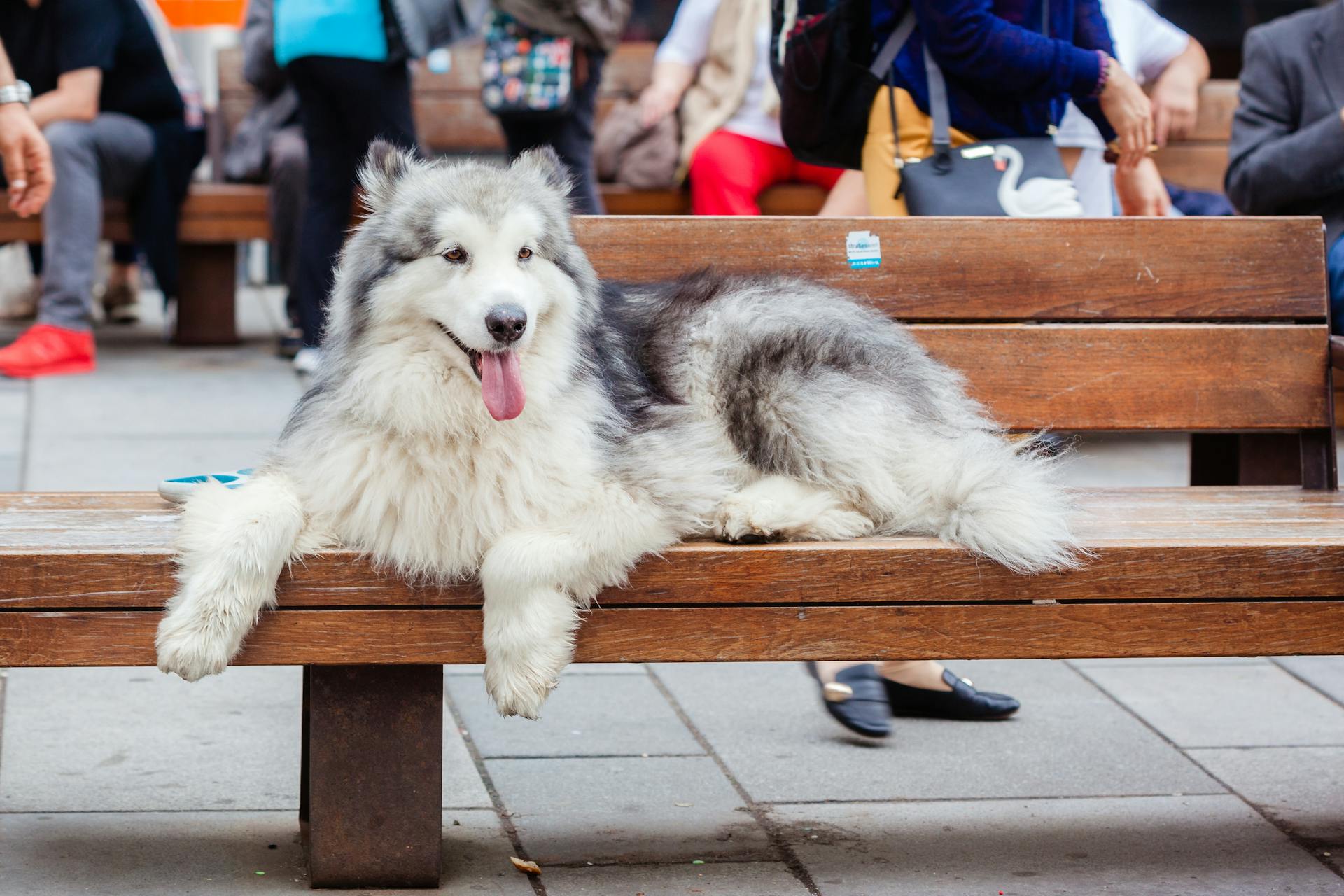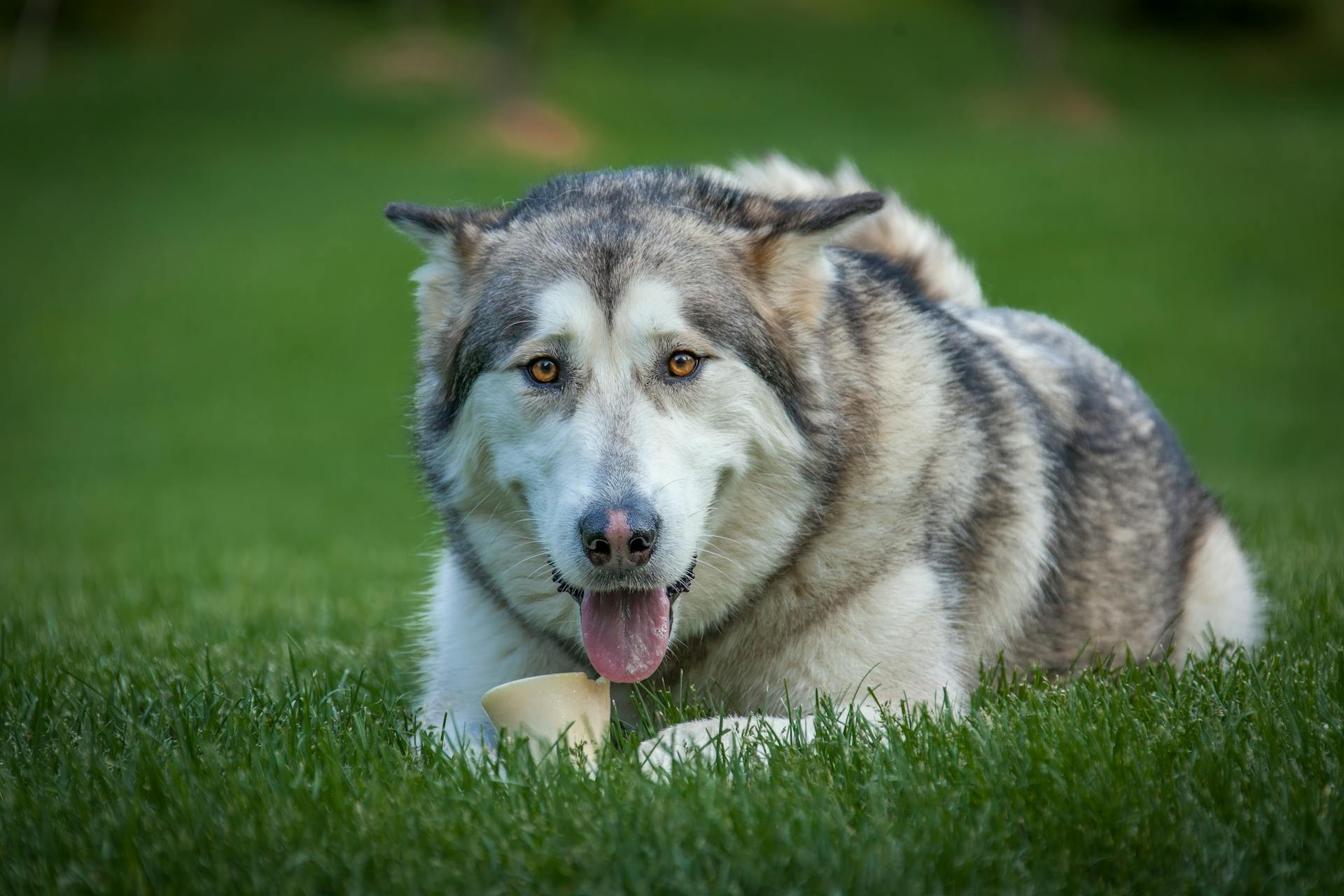
The Alaskan Malamute is a majestic breed, originating from the Arctic region of Alaska. They were bred to be strong and resilient, with a thick coat to withstand the harsh climate.
Their massive size is one of their defining characteristics, with males weighing between 70-95 pounds and standing 23-26 inches tall at the shoulder.
The Malamute's broad chest and well-sprung ribs allow for efficient breathing, enabling them to take in oxygen while running in the cold air.
Their thick double coat, made up of a coarse outer layer and a soft undercoat, helps to keep them warm in freezing temperatures.
Lineage and History
The Alaskan Malamute's lineage is a fascinating topic. The breed has a similar east Asian origin to the Greenland Dog and the Canadian Eskimo Dog, but is not clearly related to them.
These dogs were originally bred by the Malimiut Inupiaq people of Alaska's Norton Sound region. A study in 2013 showed that the Alaskan Malamute contains a possible admixture of the Siberian Husky.
The Malamute's history dates back thousands of years. The first dogs arrived in the Americas 12,000 years ago, but people and their dogs didn't settle in the Arctic until the Paleo-Eskimo people 4,500 years ago.
Here's a brief timeline of the Malamute's history:
- 12,000 years ago: First dogs arrive in the Americas
- 4,500 years ago: Paleo-Eskimo people settle in the Arctic
- 1,000 years ago: Thule people arrive in the Arctic
- 1896: Malamutes aid prospectors during the Klondike Gold Rush
- 1935: Breed recognition comes through the efforts of Mrs. Eva B. Seeley
The Malamute played a crucial role in the lives of its human companions. They worked, hunted, and lived alongside humans, and were renowned for their excellent hunting abilities.
History of the
The Alaskan Malamute has a rich and fascinating history that spans thousands of years. The breed originated in the Arctic regions of Siberia and was brought to the Americas by the Paleo-Eskimo people around 4,500 years ago.
The Malamute was bred by the Mahlemiut Inuit tribe in northwestern Alaska for centuries, and its versatility made it a valuable asset for the indigenous people. They used these dogs to pull heavy sleds, hunt seals and polar bears, and even as decoys when bear hunting.
Explore further: 100 Years Ago Original Boston Terrier
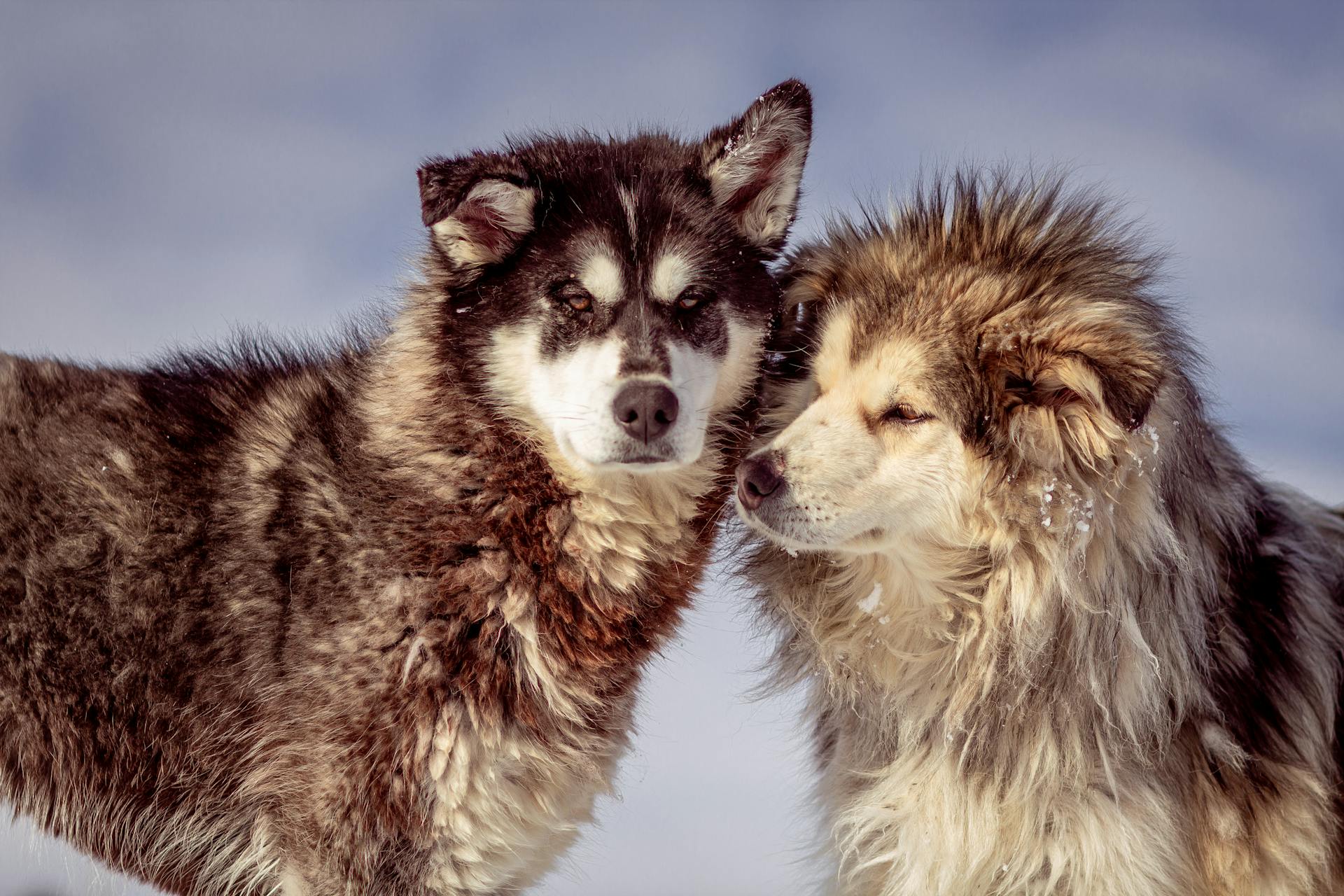
The breed's strength and stamina made it an ideal companion for prospectors during the Klondike Gold Rush. In fact, the Malamute was so valuable that it was frequently crossbred with imported breeds during this time.
Despite its usefulness, the breed was in serious decline after World War II, with some estimates suggesting that there were only 30 registered Malamutes left in 1947.
The American Kennel Club (AKC) played a crucial role in saving the breed by expanding its recognition to include the Hinman and M'Loot strains. Today, all modern Malamutes are descended from these early strains and show combinations of characteristics to a greater or lesser degree.
Here's a brief timeline of the Malamute's history:
- 12,000 years ago: The first dogs arrive in the Americas.
- 4,500 years ago: The Paleo-Eskimo people bring the Malamute to the Arctic regions of Siberia.
- 1,000 years ago: The Thule people arrive in the Arctic, bringing the Malamute with them.
- 1896: The Malamute becomes a valuable asset for prospectors during the Klondike Gold Rush.
- 1935: The AKC recognizes the Malamute as a distinct breed.
- 1947: The breed is in serious decline, with only 30 registered Malamutes left.
- 2010: The Alaskan Malamute is named the official state dog of Alaska.
Overview
The Alaskan Malamute's friendly and outgoing nature makes them a great companion for outdoor enthusiasts. They thrive on social interaction and love being around people.
One of the reasons they're perfect for hiking and biking is their high energy level. They need significant exercise and mental stimulation to stay happy and healthy.
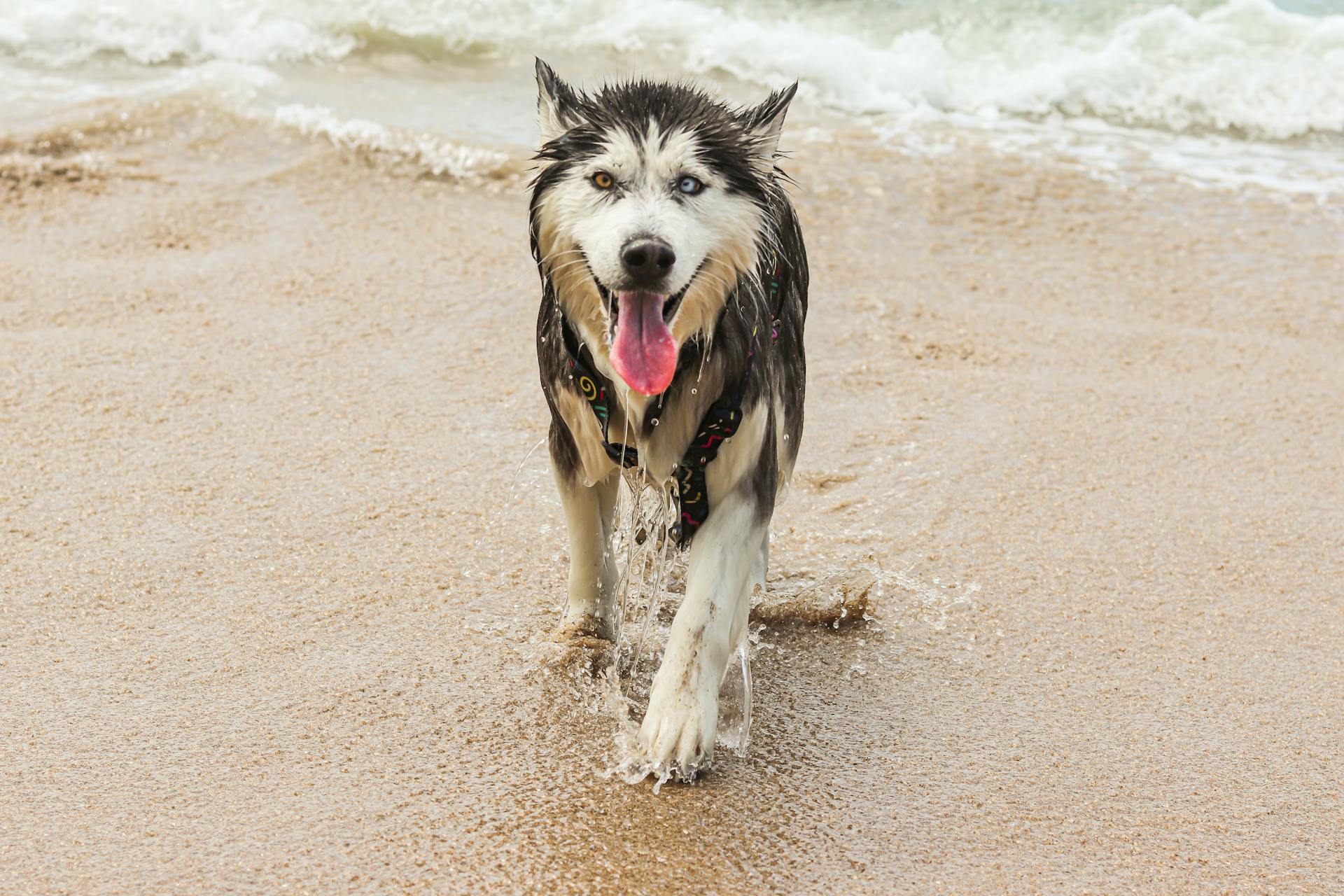
In fact, they're so intelligent and loyal that they can become dominant with other pets if not properly trained and socialized. This is something to consider if you're thinking of adding an Alaskan Malamute to your family.
Here are some key characteristics to keep in mind:
- Friendly and outgoing with people
- Intelligent and loyal nature
- Needs significant exercise and mental stimulation
Physical Characteristics
The Alaskan Malamute is a large breed dog, and you can tell by looking at them. They have wide bodies that are perfect for carrying heavy loads.
These dogs typically weigh between 75 to 85 pounds. Their height can reach up to 25 inches tall.
Appearance
Alaskan Malamutes' fur grows in several color combinations, which is usually white paired with another color, like red, agouti, black, gray, sable or seal.
Their coats can be white paired with red, agouti, black, gray, sable, or seal.
They can also be solid white.
The combination of colors can vary, but white is often the dominant color.
On a similar theme: English Springer Spaniel Colors Tri-color
Average Size
Alaskan Malamutes are large dogs with a sturdy build. They typically weigh between 75 to 85 pounds.
Their height can reach up to 25 inches.
In This Article
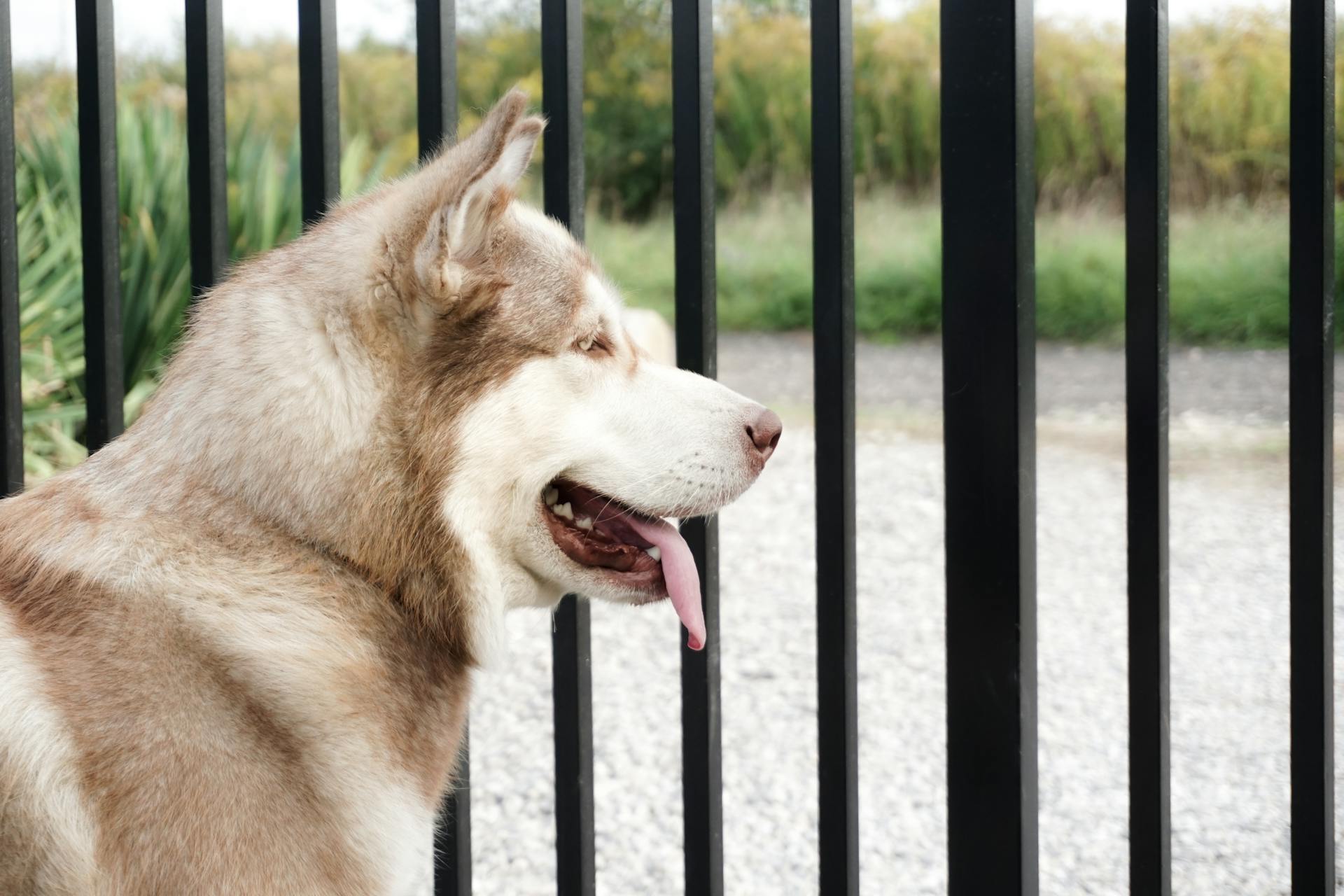
Alaskan Malamutes are a supersized breed that requires a significant investment of time and TLC. They have a loyal temperament and are incredibly affectionate, making them a lovable member of your family.
Their naturally friendly nature leads them to greet most strangers as friends, rather than foes. This might not make them the best guard dogs, but their intimidating size can still deter would-be intruders.
In terms of physical characteristics, Alaskan Malamutes have a commanding presence due to their large size and dignified manner. They are widely exhibited at international dog show events, including the Westminster Kennel Club and the Crufts Dog Show in England.
Here are some key physical characteristics of the Alaskan Malamute breed:
Alaskan Malamutes have a storied history of helping humans complete some of the world's hardest jobs, from hunting seals to hauling sleds.
Health and Care
Alaskan Malamutes are generally healthy dogs, but like any breed, they can be prone to certain health issues. They can live up to 10-14 years with proper care and attention.
Their ancestors pulled sleds for generations, so they need lots of exercise to be happy. A daily run with their human or alongside a bike helps keep these energetic dogs satisfied.
Some common health issues in Alaskan Malamutes include hip dysplasia, elbow dysplasia, and polyneuropathy. These conditions can be treated with physical therapy, surgery, or other methods, but it's essential to catch them early.
Here are some of the most common health problems in Alaskan Malamutes:
- Cancer: Canine cancer can affect many breeds of dogs.
- Elbow and Hip Dysplasia: These conditions affect your dog's joints as they mature.
- Polyneuropathy: This neurological disorder causes improper functioning of the dog's nerves.
- Hypothyroidism: Also known as underactive thyroid, hypothyroidism affects the body's natural hormone regulation and causes slowed metabolism.
- Day Blindness: Affecting the cones in the eyes, this condition can cause your dog to have poor sight or blindness outdoors and in brightly-lit areas.
- Von Willebrand Disease: This disease impairs the blood's ability to clot.
- Gastric Dilatation-Volvulus (GDV or Bloat): Large-breed dogs are often prone to Bloat, in which the stomach fills with gas and twists.
Regular grooming and attention to their robust coats are also essential. With proper care and attention, your massive Alaskan Malamute can live a happy and healthy life.
Health
Alaskan Malamutes are generally healthy dogs, but like all breeds, they can be prone to certain health issues. The average life expectancy of an Alaskan Malamute is 10-14 years.
One of the most common health problems in Alaskan Malamutes is hip dysplasia, a genetic condition that can lead to arthritis and mobility issues. This is a serious condition that can affect a dog's quality of life.
On a similar theme: Are Malamutes Good Guard Dogs
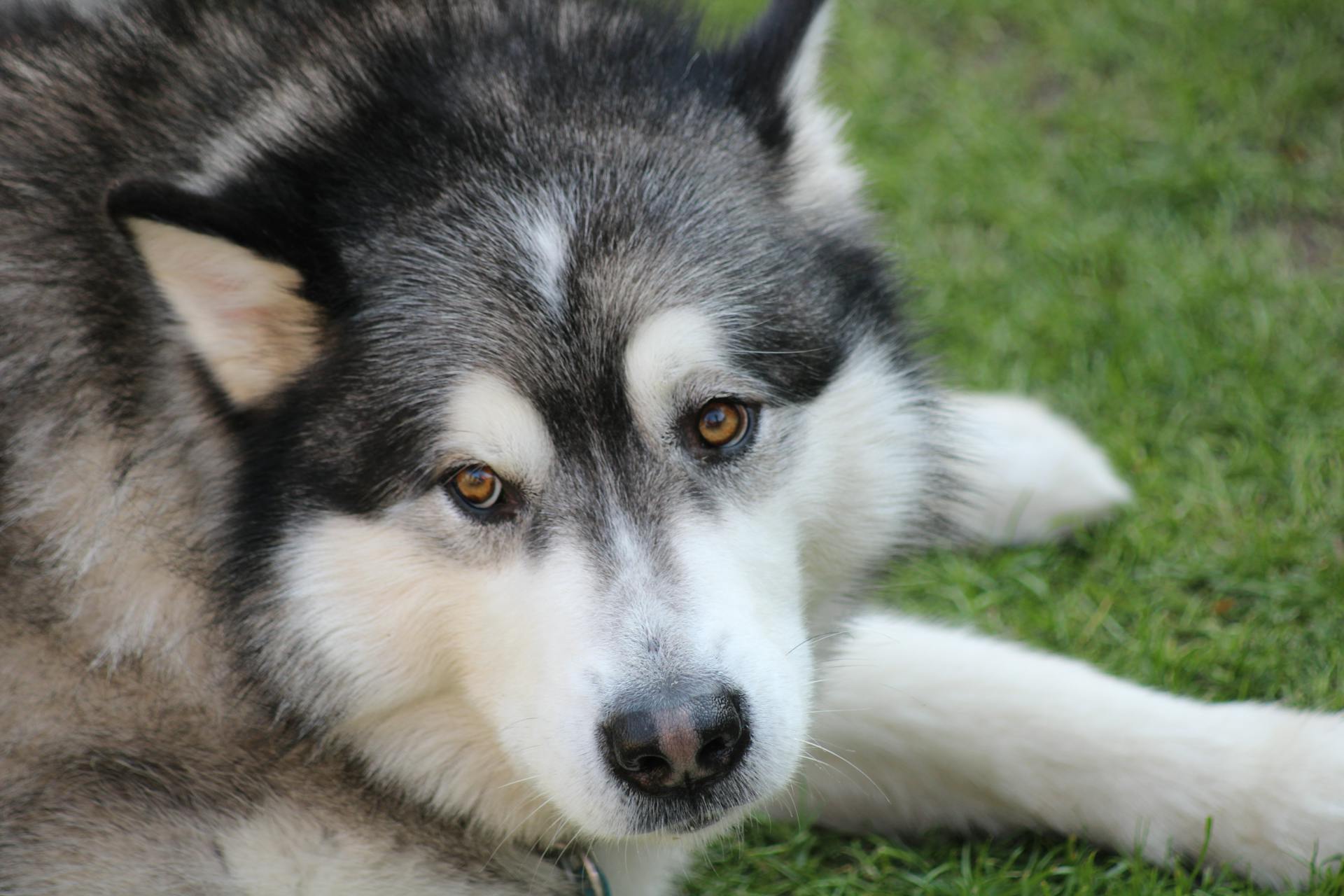
Alaskan Malamutes are also prone to elbow dysplasia, a condition that affects the elbow joint and can cause lameness and pain. Treatment for elbow dysplasia typically involves surgery and management of arthritis.
Another health issue that affects Alaskan Malamutes is thyroid disorders, specifically hypothyroidism. This is a common hormonal issue in dogs that can cause a range of symptoms including weight gain, skin problems, and fatigue.
Additionally, Alaskan Malamutes can be susceptible to eye problems, including cataracts and progressive retinal atrophy. These conditions can cause vision loss and blindness.
It's also worth noting that Alaskan Malamutes can be prone to certain genetic disorders, including polyneuropathy and von Willebrand's disease. These conditions can cause a range of symptoms including muscle weakness, seizures, and bleeding disorders.
Here are some of the most common health issues that affect Alaskan Malamutes:
- Hip dysplasia
- Elbow dysplasia
- Thyroid disorders (hypothyroidism)
- Eye problems (cataracts and progressive retinal atrophy)
- Polyneuropathy
- Von Willebrand's disease
- Gastric dilatation-volvulus (GDV or bloat)
Ear Care
Regular ear checks are a must for Alaskan Malamutes. Pet parents should check their pup's ears once a week to ensure they're free from infection. Healthy ears should be pink and free from any buildup. The AMCA recommends using disposable ear wipes to keep your pup's ears clean.
Curious to learn more? Check out: German Shorthaired Pointer Free to Good Home
Care and Maintenance
Alaskan Malamutes need a lot of exercise to be happy, and a daily run with their human or alongside a bike helps keep these energetic dogs satisfied.
Daily walks or hikes are a must, and they particularly enjoy activities like sledding, weight-pulling, agility, obedience, and nose work.
Their thick coat needs brushing daily, especially when shedding, which can be overwhelming as hair clings to your couch, carpet, and clothes.
Alaskan Malamutes shed their undercoat twice a year in both spring and fall, so be prepared to brush your dog every day and use an undercoat rake to keep stray fur under control.
They need a bath every 6-8 weeks to keep their coat healthy, smelling fresh, and free from matting.
Some Alaskan Malamutes can be escape artists, so they need to be in a safe or securely fenced area when they run.
Their ancestors pulled sleds for generations, so they require regular intense exercise to be satisfied.
A unique perspective: Malamute Shedding
Daily grooming is a must, including near-constant brushing and care for their robust coats.
Alaskan Malamutes can experience issues like day blindness, cataracts, and an underactive thyroid, so regular check-ups with a vet are crucial.
Their size and strength require clear, firm leadership, and they need to be trained with hands-on training and daily grooming in mind.
Personality and Temperament
Alaskan Malamutes are strong-willed dogs that can be dominant if they don't respect their owners. They thrive on being treated as intelligent partners in their human pack.
These dogs are naturally inclined to dominate others, especially if they don't receive proper training. Without obedience training, they can push around other pets and even be forceful with children.
Malamutes are generally friendly, eager to please, and gentle, but they can also be strong-willed and independent. They have a high prey drive and may chase smaller animals if not socialized properly.
To raise a well-behaved Malamute, it's essential to start obedience training from puppyhood. Positive reinforcement is key, as they can be too smart for their own good and may refuse to follow commands if they don't see the point.
A tired Malamute is a happy Malamute, and they need plenty of exercise to keep them satisfied. Running, pulling a sled, or skijoring are great ways to burn off their energy, but they'll also make delightful couch companions once they're exhausted.
Malamutes are highly vocal dogs that won't hesitate to let you know if they're bored, unhappy, or need attention. They crave affection from their favorite people and will often seek it out.
Frequently Asked Questions
Is there a giant malamute breed?
Yes, the Giant Malamute is a recognized breed of dog, characterized by its large size. Males typically weigh between 85-120 pounds, while females weigh between 70-95 pounds.
How tall is a giant Alaskan Malamute standing?
An Alaskan Malamute typically stands between 23-25 inches tall at the shoulder.
What's bigger a husky or a malamute?
An Alaskan malamute typically weighs between 75-85 pounds, while a Siberian husky is usually smaller, weighing between 40-60 pounds.
What is the biggest husky in the world?
The largest Husky breed is actually the Alaskan Husky, not Malamute, with males weighing up to 94 pounds. They're intelligent, affectionate, and require consistent training.
Featured Images: pexels.com

